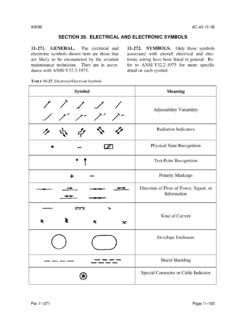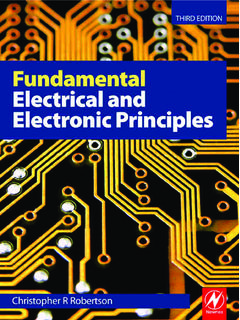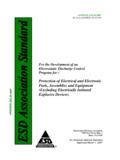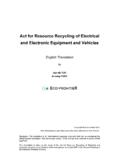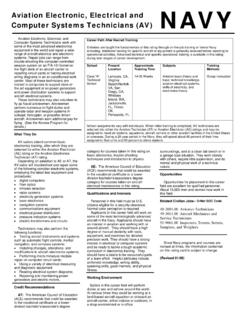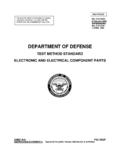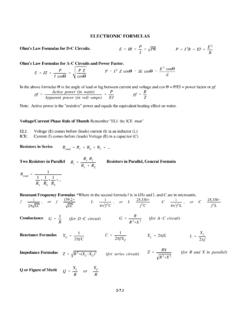Transcription of substances in electrical and electronic equipment
1 EUROPEAN. COMMISSION. Brussels, COM(2017) 38 final 2017/0013 (COD). Proposal for a DIRECTIVE OF THE EUROPEAN PARLIAMENT AND OF THE COUNCIL. amending Directive 2011/65/EU on the restriction of the use of certain hazardous substances in electrical and electronic equipment (Text with EEA relevance). {SWD(2017) 22 final}. {SWD(2017) 23 final}. EN EN. EXPLANATORY MEMORANDUM. 1. CONTEXT OF THE PROPOSAL. Reasons for and objectives of the proposal Directive 2011/65/EU (RoHS 2) sets out rules on the restriction of the use of certain hazardous substances in electrical and electronic equipment (EEE). RoHS 2 provisions apply to all EEE placed on the EU market regardless of whether they are produced in the EU or in third countries.
2 RoHS 2 affects mainly industrial manufacturers, importers and distributors of EEE, as well as EEE customers. RoHS 2 addresses the waste hierarchy's highest priority, waste prevention. Waste prevention includes measures that reduce the content of harmful substances in materials and products. Decreasing the amount of hazardous substances in electrical and electronic waste benefits the management of such waste as a result. It promotes the reuse of products and the recycling of used materials, which supports the circular economy. RoHS 2 is necessary to prevent barriers to trade and the distortion of competition in the EU, which could happen in case of disparities between the laws or administrative measures on restricting the use of hazardous substances in EEE in various Member States.
3 It also contributes to the protection of human health and to the environmentally sound recovery and disposal of electrical and electronic waste. RoHS 2 is a recast of the earlier RoHS Directive 2002/95/EC (RoHS 1). Both RoHS. directives have stimulated a reduction in hazardous materials all over the world: several countries, including China, Korea and the US, have developed RoHS-like legislation. RoHS 2 introduced new definitions and expanded the scope to cover medical devices and monitoring and control instruments. The impact of these provisions was assessed with the Commission's proposal in 2008. However, RoHS 2 also introduced further changes: the 'open scope' through a new category 11: "Other EEE not covered by any of the other categories".
4 Those changes make the Directive applicable to all EEE (except equipment that is explicitly excluded) and give a broader interpretation of EEE, based on a new definition of the dependency on electricity. These 'open scope' provisions were not specifically assessed when introduced in RoHS 2. The Commission has a mandate to examine the need to amend the Directive's scope in respect of the EEE definition and of additional exclusions of product groups covered by RoHS 2 by virtue of the open scope introduced with the 2011 recast. The Commission has carried out this assessment and identified a number of issues related to the scope of RoHS 2 that need to be addressed to avoid the legislation having unintended effects.
5 In absence of a Commission proposal, the following problems would arise after 22 July 2019: the interdiction of secondary market operations ( reselling, second-hand market). for new-in-scope EEE. This is known as the 'hard-stop';. the stop of the possibility to repair with spare parts a subset of new-in-scope EEE. once legally placed on the market before that date;. the different (distorting) treatment of cord-connected non-road mobile machinery in comparison to otherwise identical machinery powered by a battery or an engine (currently excluded from RoHS scope);. the de-facto prohibition of pipe organs placement on the EU market (as not RoHS-compliant due to the lead used to produce the wanted sound).
6 EN 2 EN. These four problems could affect the EU market, manufacturers and citizens and trigger negative economic, environmental, social and cultural impacts. The Commission's proposal therefore tackles scope problems that cannot be resolved by either substance substitution or exemptions and guidance, for specific product groups with permanent compliance problem or where scope provisions generate market distortions, namely: secondary market operations for RoHS 2 EEE which fell outside the scope of RoHS 1;. spare parts for RoHS 2 EEE which fell outside the scope of RoHS 1;. traction-drive cord-connected non-road mobile machinery;. pipe organs. The proposal also addresses lessons learnt from implementing RoHS 2, in line with its overall objectives and legal clarity requirements.
7 This initiative is not part of the REFIT agenda. Consistency with existing policy provisions By addressing secondary market operations, the proposal aims to reinstate RoHS 2 full coherence with the EU's general principles of product legislation. In particular, as set out in the Blue Guide providing horizontal guidance on the role of market placement in the EU's product legislation1: When made available on the market, products must be in compliance with the Union harmonisation legislation applicable at the time of placing on the market. Accordingly, new products manufactured in the Union and all products imported from third countries whether new or used must meet the provisions of the applicable Union harmonisation legislation when placed on the market when made available for the first time on the Union market.
8 Compliant products once they have been placed on the market may subsequently be made available along the delivery chain without additional considerations, even in case of revisions to the applicable legislation or the relevant harmonised standards, unless otherwise specified in the legislation'. Making available on the market' and placing on the market' are defined in RoHS 2. Secondary market operations, such as reselling of EEE, which may involve also repair, spare parts replacement, refurbishment and reuse, are already allowed for most (but not all) of the EEE. (1) RoHS 2 allows EEE that was outside the scope of RoHS 1, but which would not comply with RoHS 2, to continue to be made available on the market until 22 July 2019.
9 After that date however, both the first placing on the market and secondary market operations ( reselling) of non-compliant EEE will be prohibited. EEE. affected by this 'hard-stop' of secondary market operations are medical devices, monitoring and control instruments and other new-in-scope EEE. This barrier to secondary market operations is not consistent with the general harmonisation of EU. product legislation. For this reason, the Commission proposes to remove the hard- stop of secondary market operations. (2) RoHS 2 creates an exception (to the general substance restriction) for cables and spare parts for the repair, reuse, updating of functionalities or upgrading of capacity 1. :C:2016:272:TOC.
10 EN 3 EN. of the groups of EEE gradually becoming subject its scope. However, newly-in-scope EEE other than medical devices and monitoring and control instruments are not listed. This leads to the impossibility to use spare parts after 22. July 2019 and to an unjustified difference in treatment. The Commission therefore proposes to introduce a specific provision to exclude spare parts from substance restriction, so to allow the repair at any time of all EEE in RoHS 2 scope, which were placed on the EU market. (3) RoHS 2 lists 10 specific kinds of equipment that are excluded from the open scope'. provisions. One kind of equipment that is excluded ( non road mobile machinery made available exclusively for professional use') only includes machinery with an on-board power source.










